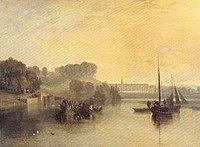Petworth House
| Petworth House | |
|
National Trust | |
|---|---|
| File:Petworth House.jpg Petworth House | |
| Grid reference: | SU976218 |
| Information | |
Petworth House is a late 17th-century mansion in Sussex, by the village of Petworth. It was rebuilt in 1688 by Charles Seymour, 6th Duke of Somerset, and altered in the 1870s by Anthony Salvin. It is an older site though, previously occupied by a fortified manor house founded by Henry de Percy, the 13th-century chapel and undercroft of which still survive.
Today's building houses an important collection of paintings and sculptures, including 19 oil paintings by J M W Turner (some owned by the family, some by Tate Britain), who was a regular visitor to Petworth, paintings by Van Dyck, carvings by Grinling Gibbons and Ben Harms, classical and neoclassical sculptures (including ones by John Flaxman and John Edward Carew), and wall and ceiling paintings by Louis Laguerre. There is also a terrestrial globe by Emery Molyneux, believed to be the only one in the world in its original 1592 state.[1]
The hosue is now owned by the National Trust.
Petworth Park and gardens
The house stands in a 700-acre landscaped park, known as Petworth Park, which was designed by Capability Brown. The park is one of the more famous in Britain, largely on account of a number of pictures of it which were painted by Turner. It is inhabited by the largest herd of fallow deer in any lordly park.
There is also a woodland garden of 30 acres, known as the Pleasure Ground.

For the past 250 years the house and the estate have been in the hands of the Wyndham family — currently Lord Egremont. He and his family live in the south wing, allowing much of the remainder to be open to the public.
The house and deer park were handed over to the nation in 1947 and are now managed by the National Trust under the name "Petworth House and Park". The Leconfield Estates continue to own much of Petworth and the surrounding area. As an insight into the lives of past estate workers the Petworth Cottage Museum has been established in High Street, Petworth, furnished as it would have been in about 1910.
Petworth House is home to the Petworth House Real Tennis Club (many such private estates held real tennis courts).

In literature
Turner's paintings have made petworth's landscapes a familiar sight.
Joan Aiken describes Petworth House and its gardens, as they were in 1798/99, in her novel "The Lightning Tree" (1980).
Outside links
| ("Wikimedia Commons" has material about Petworth House) |
| ("Wikimedia Commons" has material about Petworth Park) |
- Images of England — details from listed building database (423145) Petworth House and Estate
- Petworth House entry from The DiCamillo Companion to British & Irish Country Houses
References
- ↑ "Petworth House: Globe". Ye Olde Sussex Pages. http://www.yeoldesussexpages.com/petworth/norgal.htm. Retrieved 2008-02-07.
- Turner, Roger (1999). Capability Brown and the Eighteenth Century English Landscape (2nd ed. ed.). Phillimore, Chichester: [s.n.]. pp. 130–132.
- Petworth House information at the National Trust
